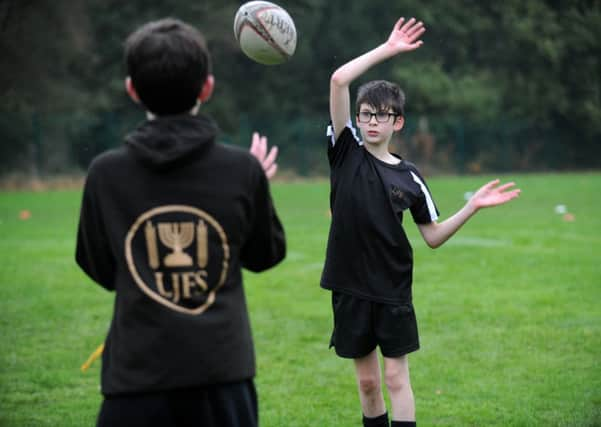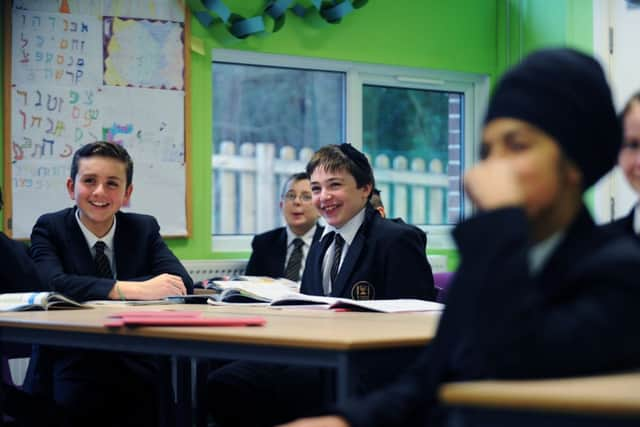Inside the £3.1m Leeds school with just 23 pupils


headteacher Jeremy Dunford is justifiably proud of his new £3.1m school.
Not only did he choose everything from the bright yellow paint used in the corridors to the purple classroom chairs, he also helped design the place.
Advertisement
Hide AdAdvertisement
Hide AdIt’s largely down to him that the food technology suite has state-of -the-art equipment and with a little help from his father, he personally selected every saw and drill in what’s known as the resistant materials workshop.


“That’s design and technology to you and me,” he says. “It’s not often that you are given a blank canvas and told to build a school, but that’s what happened here. I think I probably made more decisions in that one year than I have the entire rest of my life.”
The facilities are undoubtedly impressive, but what the Leeds Jewish Free School doesn’t have is many pupils. When it opened last year there were just eight students filing in for morning assembly. Today, there are 23 spread across two year groups - less than the average class size in most inner-city high schools.
The small intake has inevitably raised questions as to whether so much Government money should have been invested for the benefit of so few.
Advertisement
Hide AdAdvertisement
Hide Ad“I do get a little frustrated when people talk of value for money because I’m not sure it’s an appropriate question,” says Jeremy. “If you opened a £50m hospital and initially had just a handful of patients at what point do you start working out whether that’s value for money? Probably not after just two years.
“This school was always going to be small and while, yes, it cost £3m to build that’s a one-off outlay. In our original proposal the aim by this point was to have 28 students, so while we are a little down on where we want to be, we are not far off the mark.”
Currently Leeds has the third highest Jewish population in the country and those that supported the proposal claim the high school - the only one of its kind in the city - is vital to ensure the community’s long-term future.
“After the Second World War most Jewish families were just happy to live in peaceful communities,” Jeremy. “However, in recent years many have decided that they would like their children’s education to reflect their faith.
Advertisement
Hide AdAdvertisement
Hide Ad“Without a high school in Leeds, there is a real risk to the city’s Jewish community with subsequent generations moving to areas which can offer them what they want. The North East has already lost most of its Jewish population and without these kind of facilities communities do become watered down.
“I live in quite a remote part North Yorkshire and it’s a similar argument there. Rural schools are always going to have small numbers of pupils, but that doesn’t mean they shouldn’t exist. If you don’t have rural schools then families have no choice but to leave the area.”
Until the Leeds Jewish Free School opened in Alwoodley those in the city who wanted their children to receive a Jewish education had to send them to King David’s School in Manchester.
While many opted instead to apply to a local school, Jeremy insists there is a demand, just one that will take a while to be realised.
Advertisement
Hide AdAdvertisement
Hide AdBuilt on the same site as Brodetsky Primary, where he is also headteacher, numbers will increase year on year. However, even when it is full there will be just 175 pupils and under free school regulations as soon as it becomes oversubscribed it has to ensure that 50 per cent of its students come from outside the Jewish faith. Even with just a couple of dozens students, 40 per cent are already non-Jewish with Sikh, Greek Orthodox and Catholic pupils already attending the school.
In terms of the timetable, the only significant difference is that all students, regardless of faith, are required to take lessons in Jewish studies.
“Each morning we have two assemblies, a religious one and philosophical one,” says Jeremy. “Both are open to every student and we encourage them to talk to their parents about which session they should attend.
“I am not from a Jewish background, in fact I always said I didn’t want to work in a faith school. However, when I first came to Brodetsky, after being recommended by a colleague, I came to realise its importance. I think there is a case to say that if you have children of particular faith in a non-faith school who don’t take part in assemblies because of their religion or who aren’t able to have the same school meals then there is a danger that they a picked on for being different.”
Advertisement
Hide AdAdvertisement
Hide AdAccording to Jeremy, Leeds Jewish Free School represents a healthy cultural mix, but the figures have attracted criticism from other groups who have had their proposals rejected by the Department for Education despite having , on paper at least, more pupil numbers.
Teaching union officials have also questioned why public money has been invested into a Jewish free school when the wider city is facing a critical shortage of school places.
Latest figures show there are 2,346 children in class sizes of more than 30 - a threefold increase on 2010 - and a report to Leeds City Council’s executive board last month identified a funding shortfall of more than £40m over the next five years if sufficient places are to be created.
While free schools, which were introduced following the 2010 General Election to create more local competition and drive up standards while at the same time giving parents increased choice in their child’s education, the policy has been controversial.
Advertisement
Hide AdAdvertisement
Hide AdReferring to the number of free schools which are still “half empty”, Shadow Education Secretary Tristram Hunt earlier this month said that if Labour get into power at the next election there would be another overhaul of education provision with the free school model abandoned in favour of relocating facilities where they are most needed.
That’s not likely to win the vote of Simone Harris, whose daughter 11-year-old Mimi Goldberg start at the Leeds school this September.
“I was seriously considering sending Mimi to King David’s, so when they started talking about setting up a high school in Leeds it was a relief,” she says. “Like any parent I did have initial doubts. I worried about her being a guinea pig, but my husband and I talked to parents whose children had been in the first enrolment and it just felt right.
“Already I’ve seen a difference in Mimi. She now comes home and wants to talk about what she’s being doing at school and those cliques that you sometimes get in a big high school don’t seem to exist here.
“You can’t judge its success now, you have to give it time to grow.”